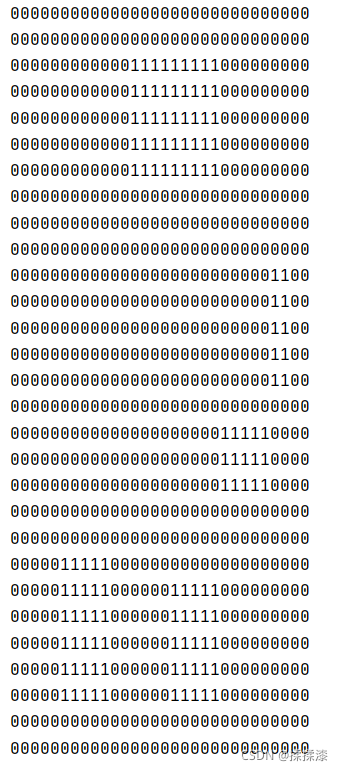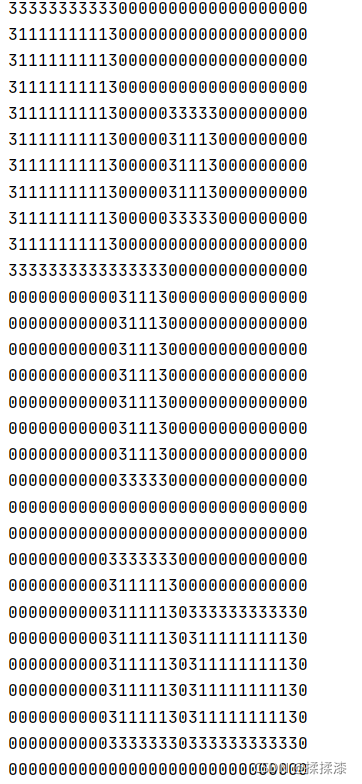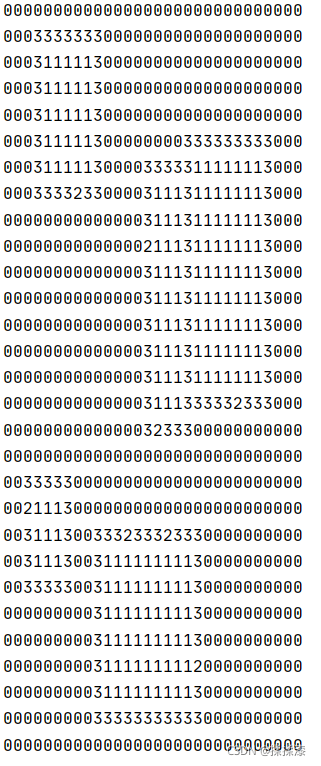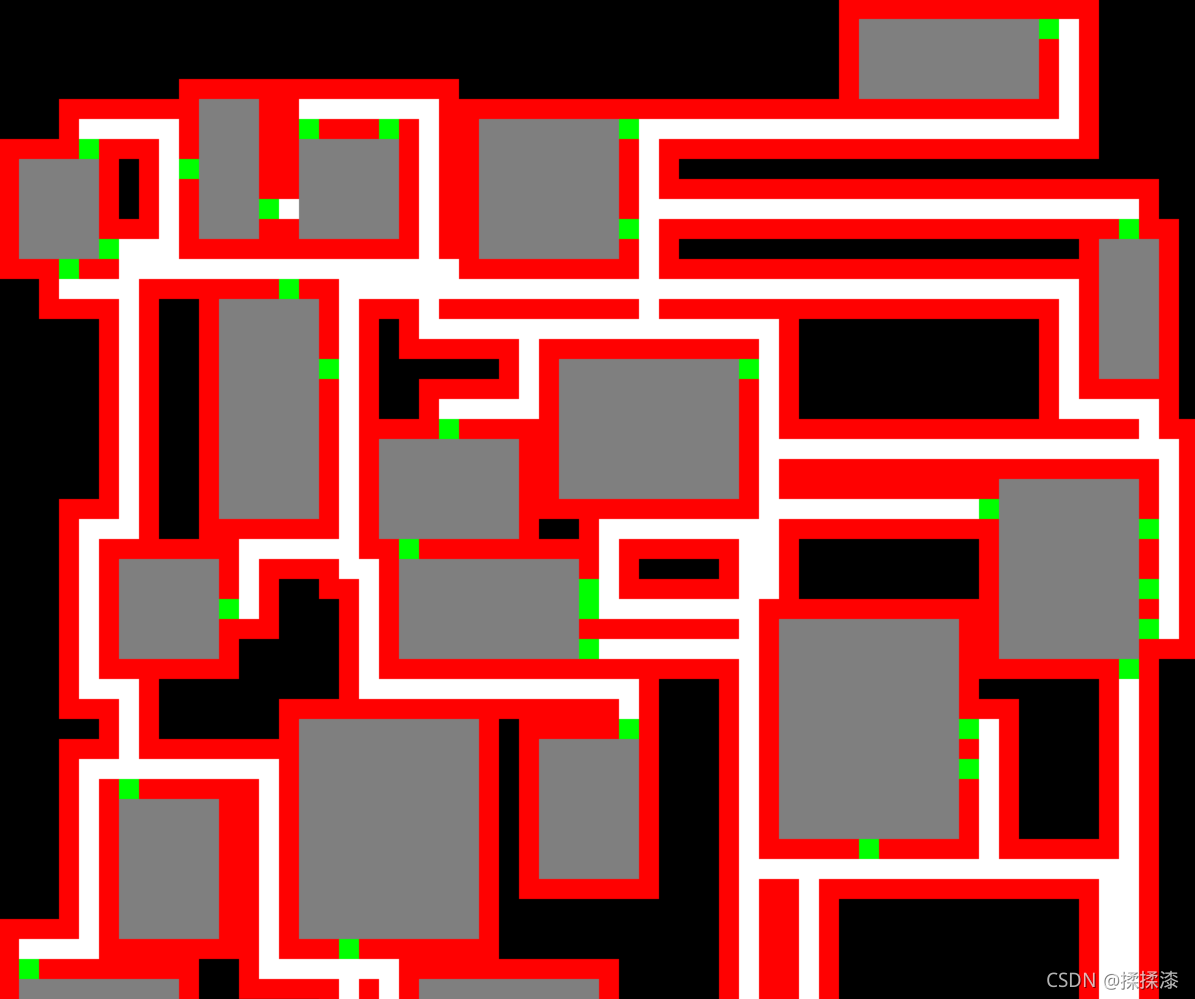python实现地牢迷宫生成的完整步骤
基本属性
定义当前地牢的等级,地图长宽,房间数量,房间的最小最大长度,如下
class Map: def __init__(self): self.width = 30 self.heigh = 30 self.level = 1 self.roomNum = 5 self.map = np.zeros((self.heigh,self.width)) self.roomMin = 3 self.roomMax = 11
生成房间
编写initRoom()随机生成房间,限制最多循环次数,为了简单起见,先做一个不会重叠的房间。基本思路是:随机房间的中心点,随机房间的长宽,再进行判断房间有无重叠(在后续会生成通道,简单起见在这里也保证房间不会紧贴),若无重叠,房间有效,房间数加1。贴代码
def initRoom(self): count = 0 roomCount = 1 while True: count += 1 if count > 300: break if roomCount > self.roomNum: break x = random.randint(1,self.width-1) y = random.randint(1,self.heigh-1) wd = random.randint(self.roomMin,self.roomMax) ht = random.randint(self.roomMin, self.roomMax) r1 = ceil(y - ht/2) r2 = ceil(y + ht/2) c1 = ceil(x - wd/2) c2 = ceil(x + wd/2) if r1 < 1: r1 = 1 if r2 >= self.heigh - 1: r2 = self.heigh - 2 if c1 < 1: c1 = 1 if c2 >= self.width - 1: c2 = self.width - 2 w = c2 - c1 + 1 h = r2 - r1 + 1 if h / w >= 3 or w / h >= 3: #保证房间不是细长的 continue judge = self.isValidRoom(r1,r2,c1,c2) if judge == 0: roomCount += 1 self.room.append(Room(r1,r2,c1,c2)) for i in range(r1,r2): for j in range(c1,c2):self.map[i,j] = 1 def isValidRoom(self,r1,r2,c1,c2): #检测有无覆盖 for i in range(r1,r2): for j in range(c1,c2): if self.map[i,j] == 1: return -1 #检测有无紧贴房间 for i in range(r1,r2): if self.map[i,c1-1] == 1 or self.map[i,c2+1] == 1: return 2 for i in range(c1,c2): if self.map[r1-1,i] == 1 or self.map[r2+1,i] == 1: return 2 return 0
看一下效果

生成墙壁
编写initTile()生成包围房间和通道的墙壁,直接贴代码
def initTile(self): offset = [[-1,0],[0,-1],[1,0],[0,1],[-1,-1],[1,1],[1,-1],[-1,1]] for i in range(self.heigh): for j in range(self.width): if self.map[i,j] == 0: tag = 0 for it in offset:if i+it[0] >= self.heigh or j+it[1] >= self.width or i+it[0] < 0 or j+it[1] < 0: continueif self.map[i+it[0],j+it[1]] != 3 and self.map[i+it[0],j+it[1]] != 4: tag += self.map[i+it[0],j+it[1]] if tag:self.map[i,j] = 3
效果

生成门口
随机选取房间的一个外围点当做房门,思路是在房间的长宽内随机两个数作为偏移量,预定义好四个方向的覆盖模板对偏移量进行加权和偏置,在这里我编写房间的类,加进地图的属性列表里。
除此之外,房间连通的思路是:在所有房间列表中随机抽出两个房间,将这两个房间连通,再随机选一个房间加回原来的房间列表,直至最后列表里只剩下一个房间。那么现在先来生成房门,代码如下
class Room(): def __init__(self,r1,r2,c1,c2): w = c2 - c1 h = r2 - r1 self.width = w self.height = h self.cx = c1 + ceil(w/2) self.cy = r1 + ceil(h/2) self.xStart = c1 self.xEnd = c2 - 1 self.yStart = r1 self.yEnd = r2 - 1 def randomTile(self): direction = random.randint(0,3) dir = [[0,1,-1,0],[1,0,0,-1],[1,0,0,self.height],[0,1,self.width,0]] x_off = random.randint(0,self.width-1) y_off = random.randint(0,self.height-1) x = self.xStart + x_off*dir[direction][0] + dir[direction][2] y = self.yStart + y_off*dir[direction][1] + dir[direction][3] if y == 0 or x == 0: return self.randomTile() else: return [y,x] class Map: def initPath(self): #初始化门 rm = self.room.copy() while len(rm) > 1: r1 = random.choice(rm) rm.remove(r1) r2 = random.choice(rm) rm.remove(r2) point0 = r1.randomTile() while point0[0] == self.heigh-1 or point0[1] == self.width-1: point0 = r1.randomTile() self.map[point0[0],point0[1]] = 2 self.door.append(point0) self.breakTile(point0) point1 = r2.randomTile() while point1[0] == self.heigh-1 or point1[1] == self.width-1: point1 = r2.randomTile() self.map[point1[0],point1[1]] = 2 self.breakTile(point1) self.door.append(point1) rn = random.randint(0,1) #a*算法寻找从point0到point1的路径 #self.aStar(point0,point1) if rn == 0: rm.append(r1) else: rm.append(r2) def breakTile(self,p): # 打通堵住的周围的墙壁 if self.map[p[0] - 1, p[1]] == 1 and self.map[p[0] + 1, p[1]] == 3: self.map[p[0] + 1, p[1]] = 2 elif self.map[p[0], p[1] - 1] == 1 and self.map[p[0], p[1] + 1] == 3: self.map[p[0], p[1] + 1] = 2 elif self.map[p[0] + 1, p[1]] == 1 and self.map[p[0] - 1, p[1]] == 3: self.map[p[0] - 1, p[1]] = 2 elif self.map[p[0], p[1] + 1] == 1 and self.map[p[0], p[1] - 1] == 3: self.map[p[0], p[1] - 1] = 2
看下效果

生成通道
接着完善上述函数,在随机选取房门后,连接两个房门。
在这我选择的是A星算法,打通两个房门,直接上代码
def aStar(self,p0,p1): open_list = [] close_list = [] offset = [[-1,0],[0,-1],[1,0],[0,1]] f = h = abs(p0[0] - p1[0]) * 10 + abs(p0[1] - p1[1]) * 10 g = 0 def isInClose(p): for it in close_list: if it.value[3] == p: return True return False def isInOpen(p): for it in open_list: if it.value[3] == p: return True return False def findFather(p): for it in close_list: if it.value[3] == p: return it.value[4] return [-1,-1] def findInOpen(p): for it in open_list: if it.value[3] == p: return it return None open_list.append(Node([f,g,h,p0,[-1,-1]])) while open_list: #for it in open_list: # print(it.value) open_list.sort(key=(lambda x:x.value[0])) f_min = open_list[0] close_list.append(f_min) open_list.remove(f_min) for it in offset: p2 = [f_min.value[3][0]+it[0], f_min.value[3][1]+it[1]] if p2[0] == p1[0] and p2[1] == p1[1]: #找到 close_list.append(Node([f,g,h,p2,f_min])) p_father = f_min.value[3] while True:self.map[p_father[0],p_father[1]] = 2p_father = findFather(p_father)if p_father[0] == -1: break self.map[p0[0], p0[1]] = 4 return if p2[0] < 0 or p2[0] >= self.heigh or p2[1] < 0 or p2[1] >= self.width: continue if (self.map[p2[0],p2[1]] != 0 and self.map[p2[0],p2[1]] != 2 and self.map[p2[0],p2[1]] != 4) or isInClose(p2): continue h = abs(p2[0] - p1[0]) * 10 + abs(p2[1] - p1[1]) * 10 g = f_min.value[1] + 10 f = h + g if not isInOpen(p2): open_list.append(Node([f,g,h,p2,f_min.value[3]])) else: #比较最小的G 值 temp = findInOpen(p2) if g < temp.value[1]:open_list.remove(temp)open_list.append(Node([f,g,h,p2,f_min.value[3]]))
效果

这样,一个随机房间的地牢就已经生成,贴上完整代码
import random
import numpy as np
from math import ceil
class Node():
def __init__(self, val=None):
if val is None:
val = [0, 0, 0, [-1, -1], [-1, -1]]
self.value = val
class Room():
def __init__(self,r1,r2,c1,c2):
w = c2 - c1
h = r2 - r1
self.width = w
self.height = h
self.cx = c1 + ceil(w/2)
self.cy = r1 + ceil(h/2)
self.xStart = c1
self.xEnd = c2 - 1
self.yStart = r1
self.yEnd = r2 - 1
def info(self):
print('r1 c1 r2 c2: ',self.yStart,self.xStart,self.yEnd,self.xEnd)
print('cx cy: ',self.cx,self.cy)
print('width height: ',self.width,self.height)
def randomTile(self):
direction = random.randint(0,3)
dir = [[0,1,-1,0],[1,0,0,-1],[1,0,0,self.height],[0,1,self.width,0]]
x_off = random.randint(0,self.width-1)
y_off = random.randint(0,self.height-1)
x = self.xStart + x_off*dir[direction][0] + dir[direction][2]
y = self.yStart + y_off*dir[direction][1] + dir[direction][3]
if y == 0 or x == 0:
return self.randomTile()
else:
return [y,x]
class Map:
def __init__(self):
self.width = 30
self.heigh = 30
self.level = 1
self.roomNum = 5
#0 is null, 1 is room, 2 is path, 3 is wall, 4 is door, 5 is up stair, 6 is downstair
self.map = np.zeros((self.width,self.heigh))
self.roomMin = 3
self.roomMax = 11
self.room = []
self.door = []
self.initRoom()
self.initTile()
self.initPath()
#self.initTile()
#self.initDoor()
def initRoom(self):
count = 0
roomCount = 1
while True:
count += 1
if count > 300:
break
if roomCount > self.roomNum:
break
x = random.randint(1,self.width-1)
y = random.randint(1,self.heigh-1)
wd = random.randint(self.roomMin,self.roomMax)
if wd % 2 == 0:
wd += 1
ht = random.randint(self.roomMin, self.roomMax)
if ht % 2 == 0:
ht += 1
r1 = ceil(y - ht/2)
r2 = ceil(y + ht/2)
c1 = ceil(x - wd/2)
c2 = ceil(x + wd/2)
if r1 < 1:
r1 = 1
if r2 >= self.heigh - 1:
r2 = self.heigh - 2
if c1 < 1:
c1 = 1
if c2 >= self.width - 1:
c2 = self.width - 2
w = c2 - c1 + 1
h = r2 - r1 + 1
if w == 0:
continue
if h == 0:
continue
if h / w >= 3 or w / h >= 3:
continue
judge = self.isValidRoom(r1,r2,c1,c2)
if judge == 0:
roomCount += 1
self.room.append(Room(r1,r2,c1,c2))
for i in range(r1,r2):
for j in range(c1,c2):self.map[i,j] = 1
def initPath(self):
#初始化门
rm = self.room.copy()
while len(rm) > 1:
r1 = random.choice(rm)
rm.remove(r1)
r2 = random.choice(rm)
rm.remove(r2)
point0 = r1.randomTile()
while point0[0] == self.heigh-1 or point0[1] == self.width-1:
point0 = r1.randomTile()
self.map[point0[0],point0[1]] = 2
self.door.append(point0)
self.breakTile(point0)
point1 = r2.randomTile()
while point1[0] == self.heigh-1 or point1[1] == self.width-1:
point1 = r2.randomTile()
self.map[point1[0],point1[1]] = 2
self.breakTile(point1)
self.door.append(point1)
rn = random.randint(0,1)
#a*算法寻找从point0到point1的路径
self.aStar(point0,point1)
if rn == 0:
rm.append(r1)
else:
rm.append(r2)
def initDoor(self):
for it in self.door:
self.map[it[0],it[1]] = 4
def breakTile(self,p):
# 打通堵住的周围的墙壁
if self.map[p[0] - 1, p[1]] == 1 and self.map[p[0] + 1, p[1]] == 3:
self.map[p[0] + 1, p[1]] = 2
elif self.map[p[0], p[1] - 1] == 1 and self.map[p[0], p[1] + 1] == 3:
self.map[p[0], p[1] + 1] = 2
elif self.map[p[0] + 1, p[1]] == 1 and self.map[p[0] - 1, p[1]] == 3:
self.map[p[0] - 1, p[1]] = 2
elif self.map[p[0], p[1] + 1] == 1 and self.map[p[0], p[1] - 1] == 3:
self.map[p[0], p[1] - 1] = 2
def initTile(self):
offset = [[-1,0],[0,-1],[1,0],[0,1],[-1,-1],[1,1],[1,-1],[-1,1]]
for i in range(self.heigh):
for j in range(self.width):
if self.map[i,j] == 0:
tag = 0
for it in offset:if i+it[0] >= self.heigh or j+it[1] >= self.width or i+it[0] < 0 or j+it[1] < 0:
continueif self.map[i+it[0],j+it[1]] != 3 and self.map[i+it[0],j+it[1]] != 4:
tag += self.map[i+it[0],j+it[1]]
if tag:self.map[i,j] = 3
def isValidRoom(self,r1,r2,c1,c2):
#检测有无覆盖
for i in range(r1,r2):
for j in range(c1,c2):
if self.map[i,j] == 1:
return -1
#检测有无紧贴房间
for i in range(r1,r2):
if self.map[i,c1-1] == 1 or self.map[i,c2+1] == 1:
return 2
for i in range(c1,c2):
if self.map[r1-1,i] == 1 or self.map[r2+1,i] == 1:
return 2
return 0
def aStar(self,p0,p1):
open_list = []
close_list = []
offset = [[-1,0],[0,-1],[1,0],[0,1]]
f = h = abs(p0[0] - p1[0]) * 10 + abs(p0[1] - p1[1]) * 10
g = 0
def isInClose(p):
for it in close_list:
if it.value[3] == p:
return True
return False
def isInOpen(p):
for it in open_list:
if it.value[3] == p:
return True
return False
def findFather(p):
for it in close_list:
if it.value[3] == p:
return it.value[4]
return [-1,-1]
def findInOpen(p):
for it in open_list:
if it.value[3] == p:
return it
return None
open_list.append(Node([f,g,h,p0,[-1,-1]]))
while open_list:
#for it in open_list:
# print(it.value)
open_list.sort(key=(lambda x:x.value[0]))
f_min = open_list[0]
close_list.append(f_min)
open_list.remove(f_min)
for it in offset:
p2 = [f_min.value[3][0]+it[0], f_min.value[3][1]+it[1]]
if p2[0] == p1[0] and p2[1] == p1[1]:
#找到
close_list.append(Node([f,g,h,p2,f_min]))
p_father = f_min.value[3]
while True:self.map[p_father[0],p_father[1]] = 2p_father = findFather(p_father)if p_father[0] == -1:
break
self.map[p0[0], p0[1]] = 4
return
if p2[0] < 0 or p2[0] >= self.heigh or p2[1] < 0 or p2[1] >= self.width:
continue
if (self.map[p2[0],p2[1]] != 0 and self.map[p2[0],p2[1]] != 2 and self.map[p2[0],p2[1]] != 4) or isInClose(p2):
continue
h = abs(p2[0] - p1[0]) * 10 + abs(p2[1] - p1[1]) * 10
g = f_min.value[1] + 10
f = h + g
if not isInOpen(p2):
open_list.append(Node([f,g,h,p2,f_min.value[3]]))
else:
#比较最小的G 值
temp = findInOpen(p2)
if g < temp.value[1]:open_list.remove(temp)open_list.append(Node([f,g,h,p2,f_min.value[3]]))
def printMap(self):
for i in range(self.heigh):
for j in range(self.width):
print(int(self.map[i,j]),end='')
print()
def printRoom(self):
for r in self.room:
r.info()
if __name__ == '__main__':
map = Map()
map.printMap()
可视化一下

总结
到此这篇关于python实现地牢迷宫生成的文章就介绍到这了,更多相关python地牢迷宫生成内容请搜索本站以前的文章或继续浏览下面的相关文章希望大家以后多多支持本站!
版权声明:本站文章来源标注为YINGSOO的内容版权均为本站所有,欢迎引用、转载,请保持原文完整并注明来源及原文链接。禁止复制或仿造本网站,禁止在非www.yingsoo.com所属的服务器上建立镜像,否则将依法追究法律责任。本站部分内容来源于网友推荐、互联网收集整理而来,仅供学习参考,不代表本站立场,如有内容涉嫌侵权,请联系alex-e#qq.com处理。
 关注官方微信
关注官方微信